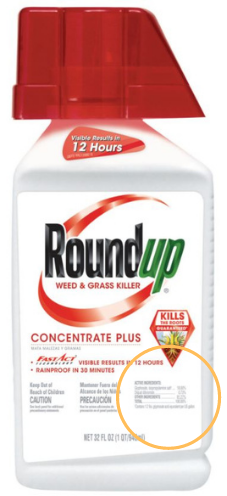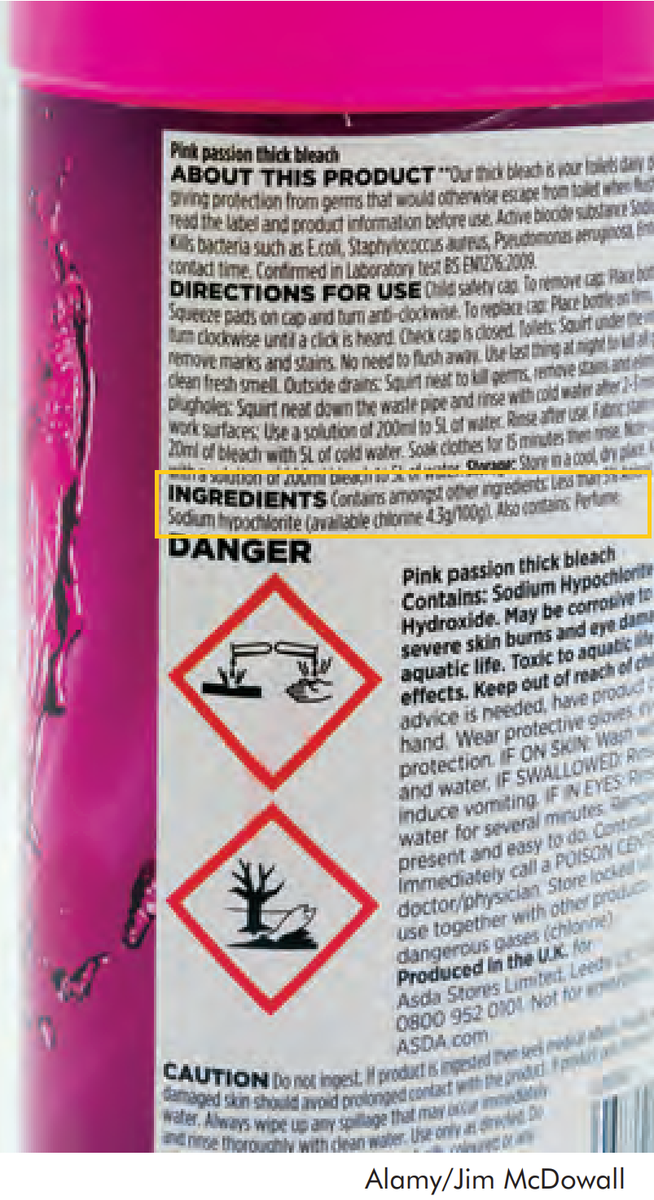Gateway on Pesticide Hazards and Safe Pest Management
How To Find Ingredients in Pesticide Products
Beyond Pesticides offers resources below to evaluate the health and ecological effects of specific chemical exposure from ACTIVE INGREDIENTS in pesticide products, as well as regulatory information and supporting scientific documents. Because various pesticide products can contain more than one active ingredient, it is important to READ the LABEL to determine chemical components.
With 192 different active ingredients and counting, it is essential to establish the connection between the use of these chemicals and their respective hazards.
View the step-by-step guide on how to search for the active ingredient(s) in pesticide products below:
- Go to U.S. EPA's Pesticide Product and Label System and enter the product name. The generic product name may vary.
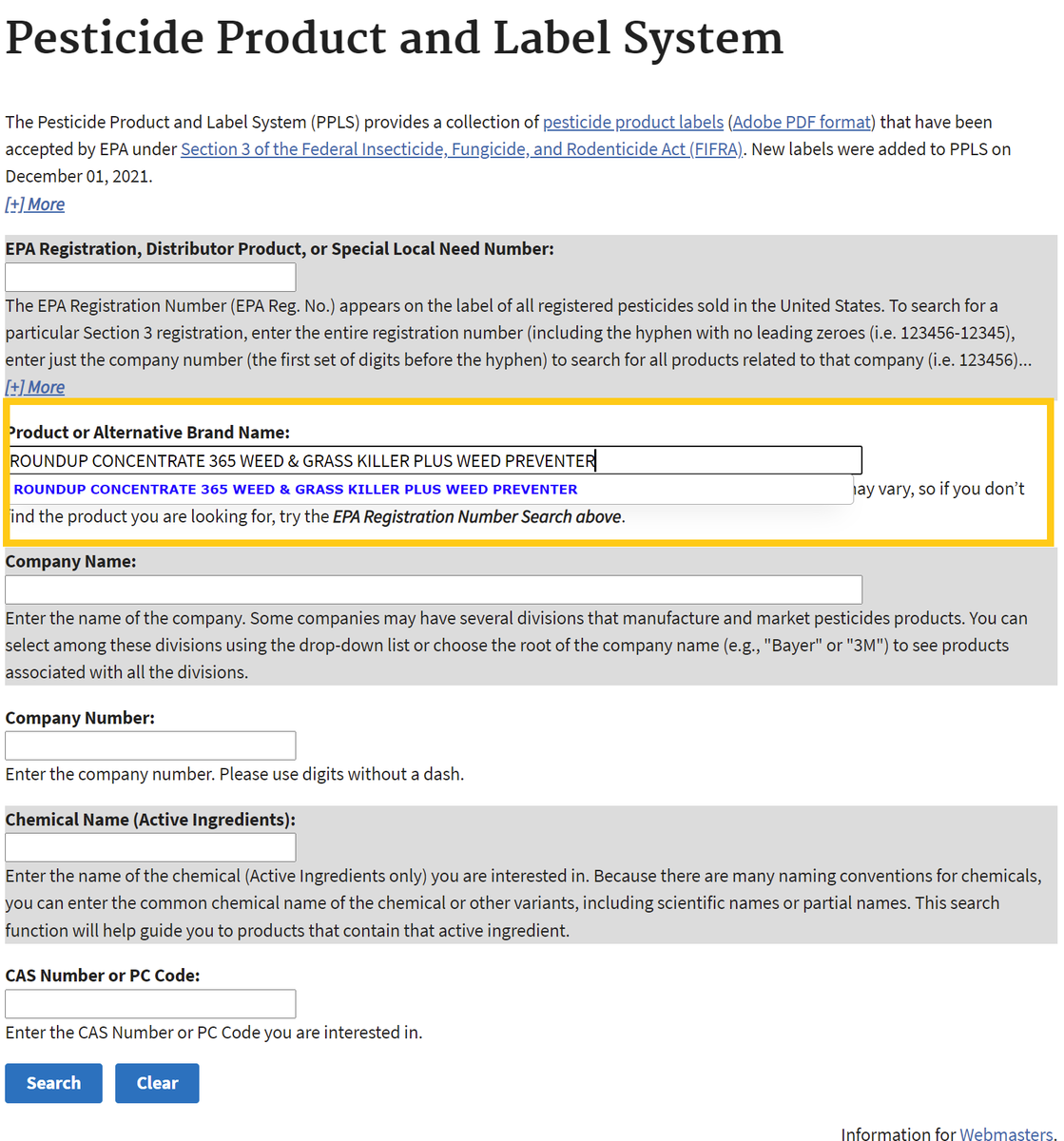
- After searching, click on the chemical ingredients tab or the link for the most recent label to find Active Ingredients.
Chemical List Label List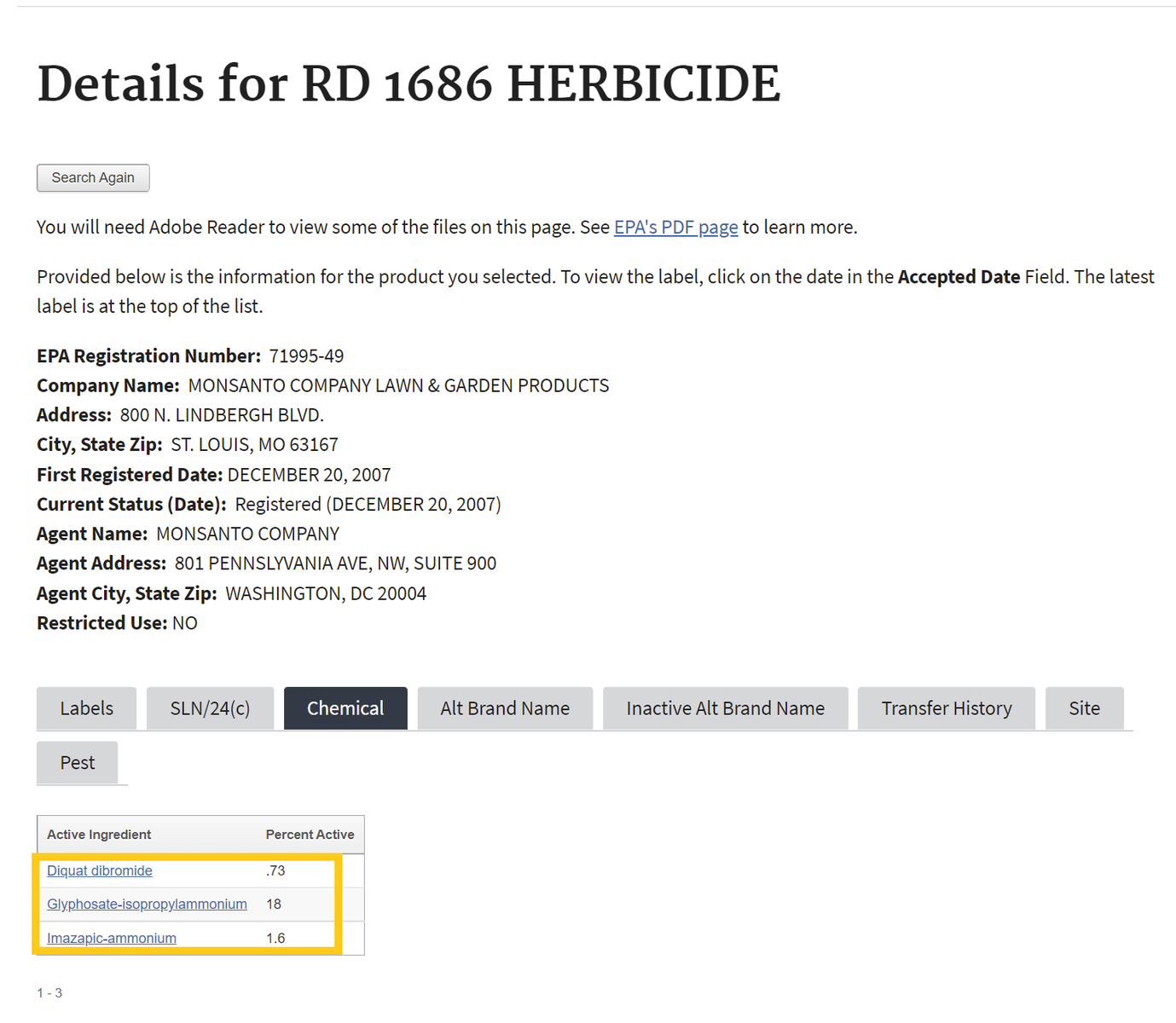
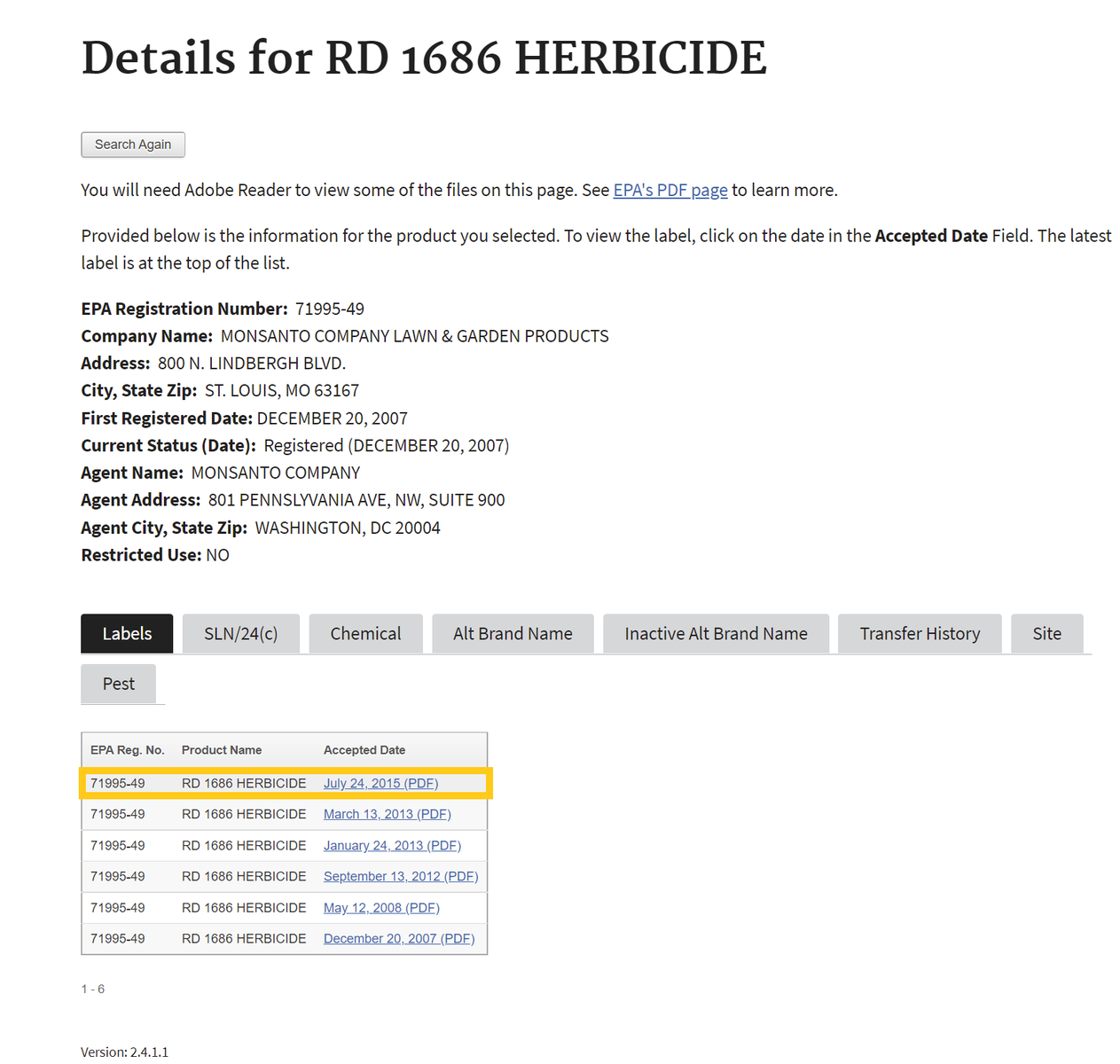
If one selects the chemical ingredients tab, skip to Step 4 . If not, proceed to step number 3 - To find the active ingredient(s) on the label, search for the page in the document containing the date of registration. Usually, the active ingredients section occurs within the first few pages of the label document.
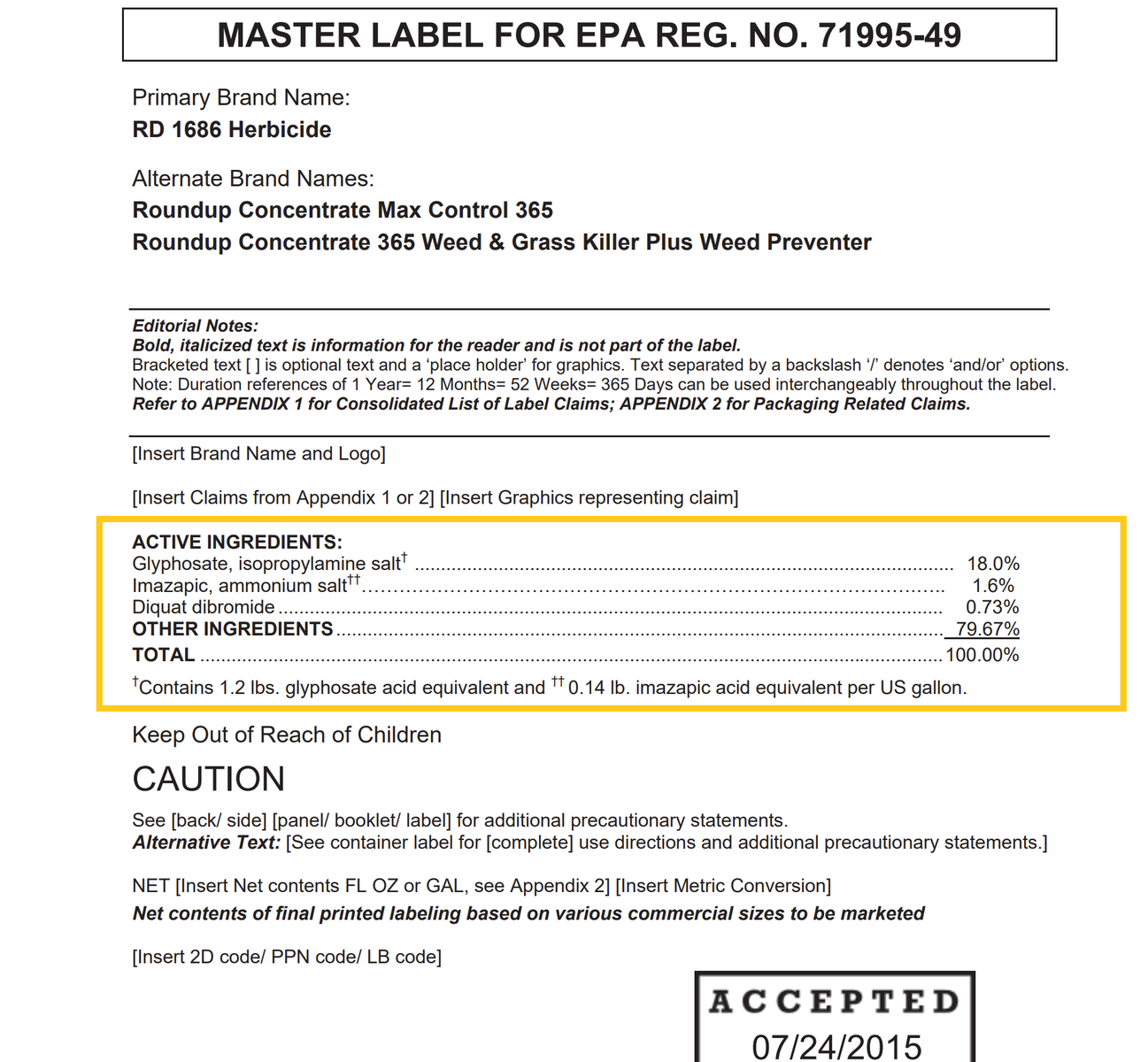
- Return to the Beyond Pesticides Gateway and search for the active ingredient name in the yellow box to the right or from the list below.
Thiamethoxam
General Information
- Product Names:
- Chemical Class: Neonictinoid
- Uses: Corn, bean, coffee, stone fruit, cucurbits, cotton, and turf
- Alternatives: Organic agriculture
- Beyond Pesticides rating: Toxic
Health and Environmental Effects
- Cancer: Not documented
- Endocrine Disruption: Not documented
- Reproductive Effects: Yes (47)
- Neurotoxicity: Not documented
- Kidney/Liver Damage: Yes (47)
- Sensitizer/ Irritant: Not documented
- Birth/Developmental: Not documented
- Detected in Groundwater: Not documented
- Potential Leacher: Yes (43)
- Toxic to Birds: Not documented
- Toxic to Fish/Aquatic Organisms: Not documented
- Toxic to Bees: Yes (MSDS)
Residential Uses as Found in the ManageSafe™ Database
Additional Information
- Regulatory Status:
- Beyond Pesticides' Neonicotinoid Comments (October 2024)
- Beyond Pesticides' comments on Preliminary Neonicotioid Assessments (04/2018)
- Beyond Pesticides' comments on Preliminary Bee Risk Assessment (7/2017)
- Thiamethoxam Registration Review
- EPA Actions on Pollinators
- Benefits of Neonicotinoid Seed Treatments to Soybean Production (EPA, 2014)
- Supporting information:
- EFSA risk assessments of three neonicotinoids – clothianidin, imidacloprid and thiamethoxam
- EU Commission: Neonicotinoids
- EFSA consultation for thiamethoxam (2016)
- Poisoned Waterways (Beyond Pesticides, 2017)
- Net Loss—Economic Efficacy And Costs Of Neonicotinoid Insecticides Used As Seed Coatings: Updates From The United States And Europe (Center for Food Safety, 2016)
- Heavy Costs: Weighing the Value of Neonicotinoid Insecticides in Agriculture (Center for Food Safety, 2014)
- The Xerces Society - Neonicotinoids and Bees
- PAN Pesticides Database: Thiamethoxam (Pesticide Action Network)
- Studies:
- A common neonicotinoid pesticide, thiamethoxam, impairs honey bee flight ability. Tosi, S, Burgio, G & Nieh, JC. 2017. Scientific Reportsvolume 7, Article number: 1201
- Effects of neonicotinoid pesticide exposure on human health: a systematic review. Cimino AM, Boyles AL, Thayer KA, Perry MJ. 2017. Environ Health Perspect. 125:155–162
- First national-scale reconnaissance of neonicotinoid insecticides in streams across the U.S.A. Hladik, M.L. and Kolpin, D.W., 2016. Environ. Chem., v. 13, pp. 12-20.
- Long-term effects of neonicotinoid insecticides on ants. Schläppi, D., Kettler, N., Straub, L., Glauser, G. and Neumann, P., 2020. Communications biology, 3(1), pp.1-9.
- Assessing Field‐Scale Risks of Foliar Insecticide Applications to Monarch Butterfly (Danaus plexippus) Larvae. Krishnan, N., Zhang, Y., Bidne, K.G., Hellmich, R.L., Coats, J.R. and Bradbury, S.P., 2020. Environmental Toxicology and Chemistry, 39(4), pp.923-941.
- Neonicotinoids: Still present in farmland birds despite their ban. Fuentes, E., Gaffard, A., Rodrigues, A., Millet, M., Bretagnolle, V., Moreau, J. and Monceau, K., 2023. Chemosphere, 321, p.138091.
- Prevalence of neonicotinoid insecticides in paired private-well tap water and human urine samples in a region of intense agriculture overlying vulnerable aquifers in eastern Iowa. Thompson, D.A., Kolpin, D.W., Hladik, M.L., Lehmler, H.J., Meppelink, S.M., Poch, M.C., Vargo, J.D., Soupene, V.A., Irfan, N.M., Robinson, M. and Kannan, K., 2023. Chemosphere, 319, p.137904.
- Comparing the effects of three neonicotinoids on embryogenesis of the South African clawed frog Xenopus laevis. Flach, H. et al. (2024) Comparing the effects of three neonicotinoids on embryogenesis of the South African clawed frog xenopus laevis, Current Research in Toxicology. Available at: https://www.sciencedirect.com/science/article/pii/S2666027X24000227?via%3Dihub.
- Mixture effects of thiamethoxam and seven pesticides with different modes of action on honey bees (Aplis mellifera). Li, W. et al. (2023) Mixture effects of thiamethoxam and seven pesticides with different modes of action on honey bees (Aplis mellifera), Scientific Reports. Available at: https://www.nature.com/articles/s41598-023-29837-w#ref-CR30.
- Residues of agrochemicals in beebread as an indicator of landscape management. Bogo, G. et al. (2024) Residues of agrochemicals in beebread as an indicator of landscape management, Science of The Total Environment. Available at: https://www.sciencedirect.com/science/article/abs/pii/S0048969724042232?via%3Dihub.
- Neonicotinoid exposure increases Varroa destructor (Mesostigmata: Varroidae) mite parasitism severity in honey bee colonies and is not mitigated by increased colony genetic diversity. Bartlett, L.J. et al. (2024) Neonicotinoid exposure increases Varroa destructor (Mesostigmata: Varroidae) mite parasitism severity in honey bee colonies and is not mitigated by increased colony genetic diversity, Journal of Insect Science. Available at: https://academic.oup.com/jinsectscience/article/24/3/20/7683866.
- Unveiling bee pollen's contamination with pesticides and mycotoxins: Current analytical procedures, results and regulation. Carrera, M. et al. (2024) Unveiling bee pollen’s contamination with pesticides and mycotoxins: Current analytical procedures, results and regulation, Trends in Analytical Chemistry. Available at: https://www.sciencedirect.com/science/article/abs/pii/S0165993624004187.
- Neonicotinoid pesticides: evidence of developmental neurotoxicity from regulatory rodent studies. Sass, J.B., Donley, N. and Freese, W. (2024) Neonicotinoid pesticides: evidence of developmental neurotoxicity from regulatory rodent studies, Frontiers in Toxicology. Available at: https://www.frontiersin.org/journals/toxicology/articles/10.3389/ftox.2024.1438890/full.
- Pesticides and prostate cancer incidence and mortality: An environment-wide association study. Soerensen, S. et al. (2024) Pesticides and prostate cancer incidence and mortality: An environment-wide association study, Cancer. Available at: https://acsjournals.onlinelibrary.wiley.com/doi/10.1002/cncr.35572.
- Honeybees fail to discriminate floral scents in a complex learning task after consuming a neonicotinoid pesticide. Julie A. Mustard, Annie Gott, Jennifer Scott, Nancy L. Chavarria, Geraldine A. Wright; Honeybees fail to discriminate floral scents in a complex learning task after consuming a neonicotinoid pesticide. J Exp Biol 1 March 2020; 223 (5): jeb217174. doi: https://doi.org/10.1242/jeb.217174
- Thiamethoxam impairs honey bee visual learning, alters decision times, and increases abnormal behaviors. Joshua C. Ludicke, James C. Nieh, Thiamethoxam impairs honey bee visual learning, alters decision times, and increases abnormal behaviors, Ecotoxicology and Environmental Safety, Volume 193, 2020, 110367, ISSN 0147-6513, https://doi.org/10.1016/j.ecoenv.2020.110367.
- Impact of Endocrine Disrupting Pesticide Use on Obesity: A Systematic Review. Pérez-Bermejo, M. et al. (2024) Impact of Endocrine Disrupting Pesticide Use on Obesity: A Systematic Review, Biomedicines. Available at: https://www.mdpi.com/2227-9059/12/12/2677.
- Widespread Use and Frequent Detection of Neonicotinoid Insecticides in Wetlands of Canada's Prairie Pothole Region. Main, A.R. et al. (2014) Widespread Use and Frequent Detection of Neonicotinoid Insecticides in Wetlands of Canada’s Prairie Pothole Region, PLOS ONE. Available at: https://journals.plos.org/plosone/article?id=10.1371%2Fjournal.pone.0092821.
- Spatial distribution of agricultural pesticide use and predicted wetland exposure in the Canadian Prairie Pothole Region. Malaj, E., Liber, K. and Morrissey, C. (2020) Spatial distribution of agricultural pesticide use and predicted wetland exposure in the Canadian Prairie Pothole Region, Science of The Total Environment. Available at: https://www.sciencedirect.com/science/article/abs/pii/S0048969719347564.
- Immune response of Brazilian farmers exposed to multiple pesticides . Jacobsen-Pereira, C.H. et al. (2020) ‘Immune response of Brazilian farmers exposed to multiple pesticides’, Ecotoxicology and Environmental Safety, 202, p. 110912. doi:10.1016/j.ecoenv.2020.110912.
- Lethal and sublethal effects of seven insecticides on three beneficial insects in laboratory assays and field trials. Fernandes, M. et al. (2016) Lethal and sublethal effects of seven insecticides on three beneficial insects in laboratory assays and field trials, Chemosphere. Available at: https://www.sciencedirect.com/science/article/abs/pii/S0045653516306051.
- Residues and Bioavailability of Neonicotinoid Pesticide in Shaanxi Agricultural Soil. Hua, L., Zhao, D., Wang, H. et al. Residues and Bioavailability of Neonicotinoid Pesticide in Shaanxi Agricultural Soil. Water Air Soil Pollut 234, 129 (2023). https://doi.org/10.1007/s11270-023-06159-1
- Eco(geno)toxicity of the new commercial insecticide Platinum Neo, a mixture of the neonicotinoid thiamethoxam and the pyrethroid lambda-cyhalothrin. Dalpiaz, F. L., Laçoli, R., Butzke-Souza, N., Santin, J. R., Poyer-Radetski, L., Dallabona, J. A., Testolin, R. C., Almeida, T. C. M., Radetski, C. M., & Cotelle, S. (2024). Eco(geno)toxicity of the new commercial insecticide Platinum Neo, a mixture of the neonicotinoid thiamethoxam and the pyrethroid lambda-cyhalothrin. Environmental pollution (Barking, Essex : 1987), 358, 124485. https://doi.org/10.1016/j.envpol.2024.124485
- Adverse Effects of Pesticides on the Ovary: Evidence from Epidemiological and Toxicological Studies. Wang, L., Ma, X. and Liu, J. (2025) Adverse Effects of Pesticides on the Ovary: Evidence from Epidemiological and Toxicological Studies, Environment & Health. Available at: https://pubs.acs.org/doi/full/10.1021/envhealth.4c00243.
- Thiamethoxam Exposure Induces Endoplasmic Reticulum Stress and Affects Ovarian Function and Oocyte Development in Mice. Liu, Y., He, Q. K., Xu, Z. R., Xu, C. L., Zhao, S. C., Luo, Y. S., Sun, X., Qi, Z. Q., & Wang, H. L. (2021). Thiamethoxam Exposure Induces Endoplasmic Reticulum Stress and Affects Ovarian Function and Oocyte Development in Mice. Journal of agricultural and food chemistry, 69(6), 1942–1952. https://doi.org/10.1021/acs.jafc.0c06340
- Do novel insecticides pose a threat to beneficial insects?. Siviter Harry and Muth Felicity 2020 Do novel insecticides pose a threat to beneficial insects?Proc. R. Soc. B.28720201265 http://doi.org/10.1098/rspb.2020.1265
- Neonicotinoid insecticides can serve as inadvertent insect contraceptives. Straub Lars, Villamar-Bouza Laura, Bruckner Selina, Chantawannakul Panuwan, Gauthier Laurent, Khongphinitbunjong Kitiphong, Retschnig Gina, Troxler Aline, Vidondo Beatriz, Neumann Peter and Williams Geoffrey R. 2016 Neonicotinoid insecticides can serve as inadvertent insect contraceptives Proc. R. Soc. B.28320160506 http://doi.org/10.1098/rspb.2016.0506
- Thiamethoxam as an inadvertent anti-aphrodisiac in male bees. Straub, L., Minnameyer, A., Camenzind, D., Kalbermatten, I., Tosi, S., Van Oystaeyen, A., Wäckers, F., Neumann, P., & Strobl, V. (2021). Thiamethoxam as an inadvertent anti-aphrodisiac in male bees. Toxicology reports, 9, 36–45. https://doi.org/10.1016/j.toxrep.2021.12.003
- Sublethal neonicotinoid insecticide exposure reduces solitary bee reproductive success. Sandrock, C., Tanadini, L.G., Pettis, J.S., Biesmeijer, J.C., Potts, S.G. and Neumann, P. (2014), Sublethal neonicotinoid insecticide exposure reduces solitary bee reproductive success. Agr Forest Entomol, 16: 119-128. https://doi.org/10.1111/afe.12041
- The neonicotinoid thiamethoxam impairs male fertility in solitary bees, Osmia cornuta. Strobl, Verena & Albrecht, Matthias & Villamar Bouza, Laura & Tosi, Simone & Neumann, Peter & Straub, Lars. (2021). The neonicotinoid thiamethoxam impairs male fertility in solitary bees, Osmia cornuta. Environmental Pollution. 284. 117106. 10.1016/j.envpol.2021.117106.
- Country-specific effects of neonicotinoid pesticides on honey bees and wild bees. Woodcock, B. A., Bullock, J. M., Shore, R. F., Heard, M. S., Pereira, M. G., Redhead, J., Ridding, L., Dean, H., Sleep, D., Henrys, P., Peyton, J., Hulmes, S., Hulmes, L., Sárospataki, M., Saure, C., Edwards, M., Genersch, E., Knäbe, S., & Pywell, R. F. (2017). Country-specific effects of neonicotinoid pesticides on honey bees and wild bees. Science (New York, N.Y.), 356(6345), 1393–1395. https://doi.org/10.1126/science.aaa1190
- Acute toxicity of 6 neonicotinoid insecticides to freshwater invertebrates. Raby, M., Nowierski, M., Perlov, D., Zhao, X., Hao, C., Poirier, D. G., & Sibley, P. K. (2018). Acute toxicity of 6 neonicotinoid insecticides to freshwater invertebrates. Environmental toxicology and chemistry, 37(5), 1430–1445. https://doi.org/10.1002/etc.4088
- Neonicotinoid mixture alters trophic interactions in a freshwater aquatic invertebrate community. Duchet, C., Hou, F., Sinclair, C. A., Tian, Z., Kraft, A., Kolar, V., Kolodziej, E. P., McIntyre, J. K., & Stark, J. D. (2023). Neonicotinoid mixture alters trophic interactions in a freshwater aquatic invertebrate community. The Science of the total environment, 897, 165419. https://doi.org/10.1016/j.scitotenv.2023.165419
- Exploring the toxicity of thiamethoxam on aquatic ecosystems: an overarching assessment of biochemical parameters, genotoxicity, fish flesh residues and histological alterations in Nile tilapia. Mansour, A. et al. (2025) Exploring the toxicity of thiamethoxam on aquatic ecosystems: an overarching assessment of biochemical parameters, genotoxicity, fish flesh residues and histological alterations in Nile tilapia, Environmental Pollutants and Bioavailability. Available at: https://www.tandfonline.com/doi/full/10.1080/26395940.2025.2493050.
- Physiological responses of oxidative damage, genotoxicity and hematological parameters of the toxic effect of neonicotinoid-thiamethoxam in Oreochromis niloticus. Temiz, Ö., & Kargın, D. (2024). Physiological responses of oxidative damage, genotoxicity and hematological parameters of the toxic effect of neonicotinoid-thiamethoxam in Oreochromis niloticus. Environmental toxicology and pharmacology, 106, 104377. https://doi.org/10.1016/j.etap.2024.104377
- Antioxidant enzyme activity and pathophysiological responses in the freshwater walking catfish, Clarias batrachus Linn under sub-chronic and chronic exposures to the neonicotinoid, Thiamethoxam®. Mukherjee, D., Saha, S., Chukwuka, A. V., Ghosh, B., Dhara, K., Saha, N. C., Pal, P., & Faggio, C. (2022). Antioxidant enzyme activity and pathophysiological responses in the freshwater walking catfish, Clarias batrachus Linn under sub-chronic and chronic exposures to the neonicotinoid, Thiamethoxam®. The Science of the total environment, 836, 155716. https://doi.org/10.1016/j.scitotenv.2022.155716
- Thiamethoxam at sublethal concentrations induces histopathological, serum biochemical alterations and DNA damage in fish (Labeo rohita). Hussain, R. et al. (2020) ‘Thiamethoxam at sublethal concentrations induces histopathological, serum biochemical alterations and DNA damage in fish (Labeo rohita)’, Toxin Reviews, 41(1), pp. 154–164. doi: 10.1080/15569543.2020.1855655.
- Histopathological Alterations in Common Carp (Cyprinus carpio L.) Gills Caused by Thiamethoxam. Georgieva, E. et al. (2014) Histopathological Alterations in Common Carp (Cyprinus carpio L.) Gills Caused by Thiamethoxam, Brazilian Archives of Biology and Technology. Available at: https://www.scielo.br/j/babt/a/kH7gVphkvCJfkLLyK9msyVs/#.
- Single and joint toxicity assessment of acetamiprid and thiamethoxam neonicotinoids pesticides on biochemical indices and antioxidant enzyme activities of a freshwater fish Catla catla. Veedu, S. K., Ayyasamy, G., Tamilselvan, H., & Ramesh, M. (2022). Single and joint toxicity assessment of acetamiprid and thiamethoxam neonicotinoids pesticides on biochemical indices and antioxidant enzyme activities of a freshwater fish Catla catla. Comparative biochemistry and physiology. Toxicology & pharmacology : CBP, 257, 109336. https://doi.org/10.1016/j.cbpc.2022.109336
- Exposure to neonicotinoid pesticides induces physiological disorders and affects color performance and foraging behavior in goldfish. Kakuta, I., & Takase, K. (2024). Exposure to neonicotinoid pesticides induces physiological disorders and affects color performance and foraging behavior in goldfish. Physiological Reports, 12, e16138. https://doi.org/10.14814/phy2.16138
- Acute toxicity of neonicotinoid insecticides to ground beetles (Coleoptera: Carabidae) from Pennsylvania. Pearsons, K. and Tooker, J. (2025) Acute toxicity of neonicotinoid insecticides to ground beetles (Coleoptera: Carabidae) from Pennsylvania, Environmental Entomology. Available at: https://academic.oup.com/ee/advance-article-abstract/doi/10.1093/ee/nvaf048/8128784.
- Neonicotinoid insecticide travels through a soil food chain, disrupting biological control of non-target pests and decreasing soya bean yield. Douglas, M.R., Rohr, J.R. and Tooker, J.F. (2015), EDITOR'S CHOICE: Neonicotinoid insecticide travels through a soil food chain, disrupting biological control of non-target pests and decreasing soya bean yield. J Appl Ecol, 52: 250-260. https://doi.org/10.1111/1365-2664.12372
- Effect of Pesticides on Adult Rove Beetle Atheta coriaria (Coleoptera: Staphylinidae) Survival in Growing Medium. Raymond A. Cloyd, Nicholas R. Timmons, Jessica M. Goebel, Kenneth E. Kemp, Effect of Pesticides on Adult Rove Beetle Atheta coriaria (Coleoptera: Staphylinidae) Survival in Growing Medium, Journal of Economic Entomology, Volume 102, Issue 5, 1 October 2009, Pages 1750–1758, https://doi.org/10.1603/029.102.0504
- Toxic and Behavioral Effects to Carabidae of Seed Treatments Used on Cry3Bb1- and Cry1Ab/c-Protected Corn. Christopher A. Mullin, Michael C. Saunders, Timothy W. Leslie, David J. Biddinger, Shelby J. Fleischer, Toxic and Behavioral Effects to Carabidae of Seed Treatments Used on Cry3Bb1- and Cry1Ab/c-Protected Corn, Environmental Entomology, Volume 34, Issue 6, 1 December 2005, Pages 1626–1636, https://doi.org/10.1603/0046-225X-34.6.1626
- Inputs, source apportionment, and transboundary transport of pesticides and other polar organic contaminants along the lower Red River, Manitoba, Canada. Challis, J. K., Cuscito, L. D., Joudan, S., Luong, K. H., Knapp, C. W., Hanson, M. L., & Wong, C. S. (2018). Inputs, source apportionment, and transboundary transport of pesticides and other polar organic contaminants along the lower Red River, Manitoba, Canada. The Science of the total environment, 635, 803–816. https://doi.org/10.1016/j.scitotenv.2018.04.128
- Occurrence of Current-Use Pesticides in Paired Indoor Dust, Drinking Water, and Urine Samples from the United States: Risk Prioritization and Health Implications. Xie, Y., Li, J., Salamova, A., & Zheng, G. (2025). Occurrence of Current-Use Pesticides in Paired Indoor Dust, Drinking Water, and Urine Samples from the United States: Risk Prioritization and Health Implications. Environmental science & technology, 59(25), 12507–12519. https://doi.org/10.1021/acs.est.5c00961
- Milkweed in agricultural field margins - A neonicotinoid exposure route for pollinators at multiple life stages. Naujokaitis-Lewis, I., Endicott, S., Gaudreault, E., Maisonneuve, F., & Robinson, S. A. (2024). Milkweed in agricultural field margins - A neonicotinoid exposure route for pollinators at multiple life stages. The Science of the total environment, 951, 175622. https://doi.org/10.1016/j.scitotenv.2024.175622
- Quantifying Pesticide Exposure Risk for Monarch Caterpillars on Milkweeds Bordering Agricultural Land. Olaya-Arenas P and Kaplan I (2019) Quantifying Pesticide Exposure Risk for Monarch Caterpillars on Milkweeds Bordering Agricultural Land. Front. Ecol. Evol. 7:223. doi: 10.3389/fevo.2019.00223
- Thiamethoxam induces meiotic arrest and reduces the quality of oocytes in cattle. Nie, Z. W., Niu, Y. J., Zhou, W., Kim, J. Y., Ock, S. A., & Cui, X. S. (2019). Thiamethoxam induces meiotic arrest and reduces the quality of oocytes in cattle. Toxicology in vitro : an international journal published in association with BIBRA, 61, 104635. https://doi.org/10.1016/j.tiv.2019.104635
- Urinary pesticide biomarkers from adolescence to young adulthood in an agricultural setting in Ecuador: Study of secondary exposure to pesticides among children, adolescents, and adults (ESPINA) 2016 and 2022 examination data. Parajuli, R. et al. (2025) Urinary pesticide biomarkers from adolescence to young adulthood in an agricultural setting in Ecuador: Study of secondary exposure to pesticides among children, adolescents, and adults (ESPINA) 2016 and 2022 examination data, Data in Brief. Available at: https://www.sciencedirect.com/science/article/pii/S2352340925006067.
- Exposure to multiple neonicotinoid insecticides, oxidative stress, and gestational diabetes mellitus: Association and potential mediation analyses. Mahai, Gaga et al. “Exposure to multiple neonicotinoid insecticides, oxidative stress, and gestational diabetes mellitus: Association and potential mediation analyses.” Environment international vol. 179 (2023): 108173. doi:10.1016/j.envint.2023.108173








.png)
